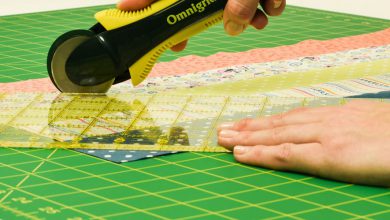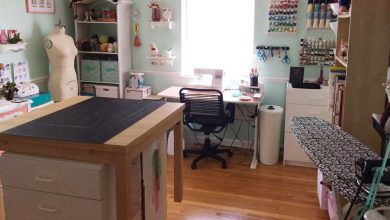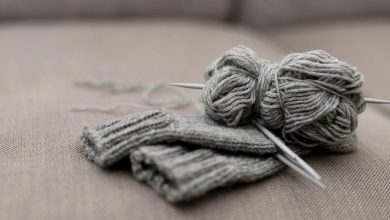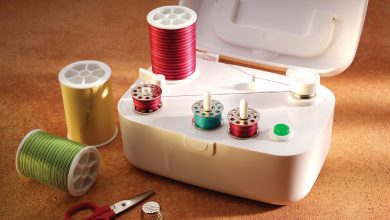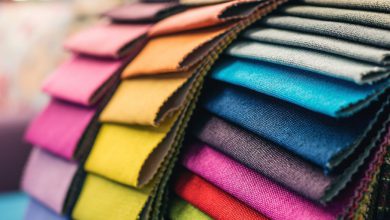An important purchase, fabric for curtains can be the difference between a stylish room that is comfortable to sleep in, and something that draws the eyes for the wrong reasons. This is why it is important to get this purchase right. Whether it is to blackout the morning sun, or to bring a little flair to a bedroom or living area, the ideal fabric for curtains can be hard to find.
With so many options out there, we have compiled a list of the best fabric for curtains to make this purchase easier. With this and our buyer’s guide, a good night’s sleep that is the perfect backdrop for a room is not far away.
- Editor’s Choice
Textiles français The Regal Birds Fabric – Denim Blue on a Natural Linen Base Cloth (Amazon) – Review - Best Check Design
5 Yards Checker Fabric- Washable | 60 (Amazon) – Review - Best Blackout
Hanes Drapery Lining Blackout Eclipse Fabric, Ivory (Amazon) – Review - Best Silk
Iridescent Cornflower Blue Dupioni Silk (Amazon) – Review - Best Design
LUSHFABRIC Bird of Paradise Ginger Plant Floral Fabric Tropical Orange Curtains Upholstery (Amazon) – Review - Best Wool Blend
Wool Blend Plaid Suiting Tan/Black Fabric by the Yard (Amazon) – Review
Editor’s Choice: Textiles français The Regal Birds Fabric – Denim Blue on a Natural Linen Base Cloth
Sold by the yard, this linen product is the best fabric for curtains as it has a unique design and a luxurious feel. Cut to order, it is 59 inches wide and the design repeats every 18 1/8 inches and is machine washable at 30 degrees. It has plenty of uses from curtains to bedding, cushions, blinds, and more.
It has such an eye-catching design that it could be used to make cushions to match the drapes and is easy to iron using medium heat. Made from 100% linen, it is lightweight yet doesn’t let as much light in as other products. There are other designs in the range with this being our favorite. To prevent fading from sun exposure it can be a good idea to use a lining to protect the fabric but otherwise, it is an excellent option.
- Excellent design
- 59 inches wide
- Easy to wash and iron
- Multiple uses
Best Check Design: 5 Yards Checker Fabric- Washable | 60
For a good blend of value and performance, the checkered design looks great and can be used for a variety of purposes. At 60 inches wide, the cut provides plenty enough for draping and it is made from 100% polyester. It is a popular product as a fabric for curtains but can also be used as a table cloth.
A one-piece fabric, it is machine washable on low heat and easy to cut to size. Because it is a premium product, it can withstand frequent washing so the 1-inch checks always look their best. Ordering 2 x 5 yards will ensure the piece is delivered as a 10-yard piece and with many customers saying it is easy to sew, there is a lot to like about this fabric for curtains.
- 60 inches wide
- 100% polyester
- Pleasant check design
- Machine washable
- Not as good at blocking light
Best Blackout: Hanes Drapery Lining Blackout Eclipse Fabric, Ivory
Fabric for curtains that will blackout the morning light and help everyone get a better night’s sleep. Ideal for kids’ rooms as well as adults, the pleasant ivory color fits well into most color schemes and is a medium/heavyweight fabric at 8.3 oz. 100% polyester, it is durable and measures 54 inches wide.
It is sold by the yard and cut to order so it doesn’t matter how much is needed, it is possible to get the right cut to cover the windows in any room. There are also thermal and noise insulation benefits to using this fabric for curtains and is also available in white. Made from acrylic latex foam and electrostatic rayon flock it is a blackout solution for many.
- Blackout drapes
- 100% polyester
- Cut to order
- 54 inches wide
- Difficult to iron
Best Silk: Iridescent Cornflower Blue Dupioni Silk
For a luxurious feel, silk is an excellent fabric for curtains and this blue dupioni product is among the best. With handwoven slubs throughout its weave, it has a pleasant texture that looks and feels great. We like the fact that it is yarn-dyed bringing out the best in the tiffany blue. At 44 inches wide, there is plenty enough of it to cut for draping and it is cut by the yard.
Although silk lets in more light than some of the options, it hangs nicely and has a glossy look that is hard to better. The main problem is that these are not good with spills of any sort so are best kept out of the kitchen and bathrooms.
- Cut to order
- 44 inches wide
- Look great
- Handwoven slubs
- Not so easy to wash
Best Design: LUSHFABRIC Bird of Paradise Ginger Plant Floral Fabric Tropical Orange Curtains Upholstery
At 55” wide and sold by the yard, this attractive fabric for curtains is a feast for the eyes with its pleasant mix of floral and tropical design. Because of its blend of polyester and cotton (20% cotton), it hangs well and is resistant to creasing. Even when it needs a wash, it is fine to go through a cycle in the right settings.
The pattern repeats every 64 x 64 cm and has a weight of 200 gr/m2 so it has a luxurious feel and can be used for blinds, bedspreads, cushions, and other upholstery. A versatile product that can easily be cut for draping.
- Attractive tropical design
- 20% cotton 80% polyester
- 200 gr/m2 weight
- Easy to iron and wash
- Can be a bit pricey for some
Best Wool Blend: Wool Blend Plaid Suiting Tan/Black Fabric by the Yard
At 60 inches wide and cut to order, this wool blend is a great way of insulating a room via the curtains. Despite being 50% wool it has a lightweight feel and although it is typically used for making blazers and skirts among other items, it can be used as curtains.
The tan and black plaid design are neutral enough to fit into most color schemes and they are better at blocking light than a lot of the alternatives. A lot of people comment that it is easy to work with and any leftover cuts can be used for different crafts.
- Insulated
- 50% wool 50% acrylic
- Pleasant tan and black plaid
- Not as easy to wash
A decision that is as important as any in the home because they will hang there for a long time, buying the right fabric for curtains is crucial. Not only can it enhance the mood and complement a color scheme, but there are plenty of practical reasons to take this purchase seriously.
This is why we have created the following buyer’s guide. By the end of it, you’ll know why some are better than others and can make an informed decision.
Width
The fabric will need to be wide enough to hang properly as otherwise, you will find yourself trying to patch two pieces of material together to ensure the right fit.
Cut To Order
Most companies do this as standard but be sure to check before ordering. You will want a consistent piece of fabric to cut to size and order enough yards for the job or you will be left with the fabric you cannot use.
Design
This is an important decision as the pattern or design on the fabric for curtains will determine how your home looks. There are plenty to choose from with floral designs still being popular, and those with wildlife remain a hit.
Color
Again, a matter of personal choice, but an important one. Finish off a room by complementing the color scheme and choose wisely. Look for materials that are not prone to fading if you get a lot of days of sun.
Easy To Wash
Some materials are better than others at this and if choosing fabric for curtains in a kids room, this can be an important part of the decision. A lot of materials are machine washable, others require a dry clean, just be sure to check the label before attempting to wash them yourself.
Multiple Uses
This might not be an essential part of what will sway a decision but it can be useful to know. If the cut-offs can be put to good use, it is possible to make cushions and pillowcases to match the curtains.
The good news is there are plenty to choose from, with some of the main choices covered below:
Cotton and Linen
These are lightweight, breathable fabrics that look decorative and delicate. Their main issue is that they let in more light than a lot of the alternatives but with a lining, this can be sorted out. The lining will also protect against sun damage as they can be known to fade over time, but are easy to look after and look great.
Wool
If you need to insulate a room, then wool is an excellent option. Heavy and thick, they have a cozy feel making them ideal for those wintery months. However, they are difficult to wash but block out a lot of light and usually available in a multitude of patterns and designs.
Synthetic
Usually a polyester or nylon option, they can be part of a blend that helps to keep the cost down. An affordable option yet one that is hard-wearing has partial light blocking but can easily be combined with blackout material and is easier to clean than most. Because of their popularity, synthetic blends are available in plenty of colors and designs to complement any living space
Silk
With a luxurious feel, silk always looks the part. They hang beautifully and although they let a bit of light in, they can be lined to counter this. Without lining they are prone to fading so this is always a sensible idea and this material does come at a price so expect to have to pay a little more.
Velvet
A thick, rich material that has some of the best light blocking available. It has a luxurious feel and is often available in deep, rich colors. Velvet is also good at keeping the cold at bay, including the room but it is also one of the more expensive options. However, it is hard-wearing but is heavy so make sure the curtain pole and wall attachments are strong enough.
Linen
Avoid the dressmaking thickness of light linen and opt for a medium-heavy weighted fabric. They do tend to wrinkle so will require dry cleaning to maintain the best appearances but after every wash, they hang pleasantly and looks great.
With the above benefits, it can be a matter of personal preference. When it comes to backing out the light, thicker materials such as wool and even velvet can be useful. Still, it is possible to combine a lining and blackout lining with most materials.
Linen and silk hang particularly well, meaning they will look great but when it comes to affordability and design options, synthetic fabric for curtains are worth considering. If choosing silk, faux silk can be a good option, or just avoid using this material in places that are prone to splashing from water such as the kitchen or bathroom. The best fabric for curtains always depends on the intended use, where it will be placed, and of course, personal taste.
Although there are plenty of options for cutting fabric into curtains, some are better than others. That’s why we recommend sticking with the usual suspects above. It is also important to get the right thickness is a light fabric intended for dressmaking is not always going to be well suited to curtains.
A general rule is that choosing at least a shade either lighter or darker than the walls is a good idea, sticking with a similar set of undertones. If you can find more than one step light or darker then even better as rich colors look best against light backdrops.
Because of the range of materials and patterns, thickness, weight, and more, there is an equally vast range of prices. Expect to pay by the yard with materials like velvet being on the more expensive end and synthetic and synthetic blends being on the more affordable side. Something in between would be cotton with printed linen designs costing around $30 – $50 a yard.
It is possible to get synthetic blends for much cheaper but again, printed or woven designs are going to increase the price. Stick within a budget, consider the best fabric for the space it is going to hang and choose the right color and design based on the surroundings.







